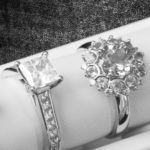Lab-grown diamonds are real diamonds created in a laboratory. Unlike earth-mined diamonds, lab-grown diamonds are man-made using either a high-pressure/high-temperature or vacuum-based process. They’re real diamonds, just created differently.
How can you tell a lab-grown diamond from a natural one? It’s not easy, but there are some things you can do.
Perform a Visual Inspection
You cannot tell a lab-grown diamond from a natural diamond just by looking at them. Both types of diamonds look exactly the same; they both come in a variety of colors and shapes, with identical brilliance and sparkle. You simply can’t tell the difference between the two with the naked eye.
Look for an Inscription
If you have a jeweler’s loupe with 20X (or higher) magnification, you can examine the diamond for an inscription. Lab-grown diamonds typically are inscribed as lab-grown when they’re graded; natural diamonds are not. The inscription is usually found on the widest part of the diamond, known as the girdle. Know, however, that not all lab-grown diamonds are inscribed in this fashion, so this isn’t a sure-fire test.
Use a Magnet
Interestingly, many lab-grown diamonds contain a trace amount of iron or nickel, created during the manufacturing process. These metallic inclusions are not visible to the naked eye or with a normal jeweler’s loupe. Instead, you can sometimes determine the presence of these tiny pieces of metal by using a magnet.
Use something more powerful than a typical refrigerator magnet. Look at your local hardware store for a Neodymium magnet; they typically cost less than $10. Touch the magnet to the unmounted diamond and see if you can lift the stone. You can also float the diamond in a bowl of water and see if the magnet pulls it in that direction.
If the magnet lifts or moves the diamond, it’s probably lab-grown. If there is no magnetic attraction, it’s more likely to be a natural diamond – although this test isn’t always conclusive. Not all types of lab-grown diamonds contain traces of metal, and the test is less predictive with smaller diamonds under a half-carat.
Have a Jeweler Do a Test
A better way to determine if a diamond is lab-grown is to have your jeweler inspect the diamond with a machine called a screener. This machine tests the chemical composition of a diamond for specific trace elements.
Most lab-grown diamonds test as Type IIa, which means that they contain mainly carbon and very little nitrogen. Less than 2% of earth-mined diamonds are Type IIa, however, as natural diamonds tend to contain a mixture of nitrogen and carbon atoms. So, if a diamond tests as Type IIa, it’s probably lab-grown.
Consider the Cost
Finally, compare the cost of the diamond with similar stones. Because lab-grown diamonds are created rather than mined, they typically cost 30% – 40% less than traditional diamonds. In the end, only your wallet will know if you purchased a lab-grown diamond or a natural one.
The Bottom Line
Lab-grown diamonds are a great option for many buyers – they cost less than natural diamonds, they’re better for the environment, and they’re visually indistinguishable from earth-mined stones.
Buy or Sell Gold & Diamond Rings in Calgary
Whether you’re in the market for a natural or a lab-grown diamond, it’s important to find a reputable dealer you can trust. With more than 40 years in the business, John Ollmann at Calgary’s Gold & Diamond Buyers has made it his mission to educate diamond buyers. He can help you choose the right diamond for your needs.
Thinking about purchasing a diamond here in Calgary? John Ollmann has the reputation and experience to help you today! Contact us today to learn more.
Don’t go into debt for a diamond engagement ring
Talk to a dedicated Diamond Educator at our Calgary affordable diamond store.


